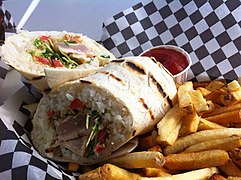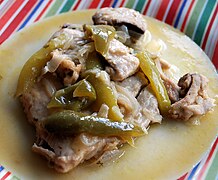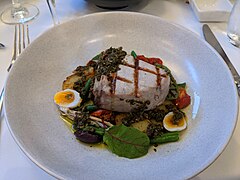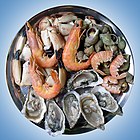
Tuna salad is a salad dish consisting of tuna and mayonnaise. The tuna used is usually pre-cooked, canned, and packaged in water or oil. Pickles, celery, relish, and onion are popular ingredients to add. Tuna salad is also regularly served by itself, or on top of crackers, lettuce, tomato, or avocado. Chopped boiled eggs may be added.

Indonesian cuisine is a collection of various regional culinary traditions that formed in the archipelagic nation of Indonesia. There are a wide variety of recipes and cuisines in part because Indonesia is composed of approximately 6,000 populated islands of the total 17,508 in the world's largest archipelago, with more than 1,300 ethnic groups.
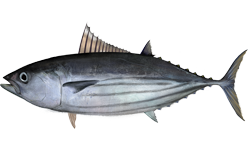
The skipjack tuna is a perciform fish in the tuna family, Scombridae, and is the only member of the genus Katsuwonus. It is also known as katsuo, arctic bonito, mushmouth, oceanic bonito, striped tuna or victor fish. It grows up to 1 m (3 ft) in length. It is a cosmopolitan pelagic fish found in tropical and warm-temperate waters. It is a very important species for fisheries.

Poke is a dish of diced raw fish tossed in sauce and served either as an appetizer or a main course.

Garudhiya or Garudiya is a clear fish broth. It is one of the basic and traditional food items of Maldivian cuisine. The broth is based on tuna species found in the nation's ocean waters such as skipjack (kanḍumas or goḍa), yellowfin tuna (kanneli), little tunny (lațți), or frigate tuna (raagonḍi).

Rihaakuru is a tuna-based thick sauce. The color varies from light brown to dark brown. It is a traditional dish of Maldivian cuisine, consumed almost daily in every household in Maldives and in Minicoy since ancient times. Rihaakuru is produced as a by-product of the processing of tuna.

Japanese cuisine has a vast array of regional specialities known as kyōdo ryōri (郷土料理) in Japanese, many of them originating from dishes prepared using local ingredients and traditional recipes.

Maldives fish is cured tuna traditionally produced in Maldives. It is a staple of the Maldivian cuisine, Sri Lankan cuisine, and the cuisine of the Southern Indian states and territories of Lakshadweep, Kerala and Tamil Nadu, and in the past it was one of the main exports from Maldives to Sri Lanka, where it is known as umbalakaḍa (උම්බලකඩ) in Sinhala and masikaruvadu in Tamil. It is also produced in small scale using traditional methods in Lakshadweep Islands in India. It is known as massmin in Lakshadweep.

Maldivian cuisine, also called Dhivehi cuisine, is the cuisine of the Republic of Maldives. The traditional cuisine of Maldivians is based on three main items and their derivatives: coconuts, fish and starches.

The cuisine of Minnesota is a type of Midwestern cuisine found throughout the state of Minnesota.

Mas huni is a typical Maldivian breakfast, comprising tuna, onion, coconut, and chili. All ingredients are finely chopped and mixed with the grated meat of the coconut. This dish is usually eaten with freshly baked roshi (flatbread) and sweetened hot tea.
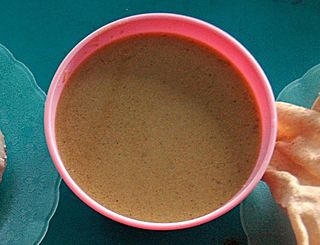
Mas riha is a fish curry of the Maldivian cuisine.

Cakalang fufu is a cured and smoked skipjack tuna clipped on a bamboo frame, a Minahasan delicacy of North Sulawesi, Indonesia.

Gulha is a typical and popular Maldivian short eat.

Minahasan cuisine or Manado cuisine is the cooking tradition of the Minahasan people of North Sulawesi, Indonesia. It is popularly known as "Manadonese cuisine" after Manado, the capital of the province, although other cities in Northern Sulawesi, such as Bitung, Tomohon and Tondano, are also known as Minahasan culinary hotspots. Manadonese cuisine is known for its rich variations in seafood, generous amount of spices, extra-hot condiments, exotic meats, and European-influenced cakes and pastries. Popular Manadonese dishes include tinutuan, cakalang fufu, cakalang noodle, paniki, chicken or various fish and seafood spiced in rica-rica or woku spices, chicken tuturuga, and brenebon.
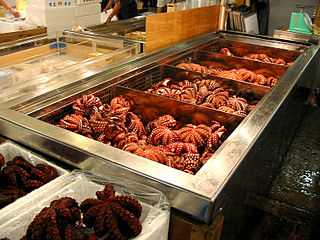
People of some cultures eat octopus. The arms and sometimes other body parts are prepared in various ways, often varying by species and/or geography.

Indonesian noodles are a significant aspect of Indonesian cuisine which is itself very diverse. Indonesian cuisine recognizes many types of noodles, with each region of the country often developing its own distinct recipes.










